The suit jacket is one of the most complex pieces of clothing known to man. There are so many types of jackets, and enough jargon to fill in a dictionary. “Single-breasted”, “double-vented”, “structured”, “jetted pockets”, “half-lined”, it’s all a lot to take in. Thanks to all that selecting a proper jacket can be challenging.
This article is going to explain the parts of a jacket and the different options available. Please keep in mind that for the purpose of this article, the term “jacket” will suit (pardon the pun) suit jackets, sport jackets, sport coats, and blazers alike. The information presented can be applied to all these jackets.
Let’s start with the front.
The Breasts
On the left, we have a single-breasted jacket; on the right, we have a double-breasted jacket. SB and DB, for short. “Breasted” in jacket-speak refers to the buttons on the anterior. The difference, as you may have noticed, is that the SB has one vertical row (column) of buttons, while the DB has two.
The Button Stance
The stance refers to the depth of the V-shape formed at the front of a closed jacket. The more buttons that are present, the higher the stance will be. The amount of buttons range from 1-3. Even more, in the case of DBs. 2 and 3 button suit suits are the most prevalent.
The level of formality depends on how much of yourself you cover up. 1-button suits are considered the least formal, and 3-button are suits the most. 2-buttons are a nice middle ground stance.
Button Materials
Buttons can be made from pretty much any material. The most commonly used materials include cloth (usually the same as the jacket’s), mother of pearl, horn, metal, and plastic.
The Lapels
Lapel Types
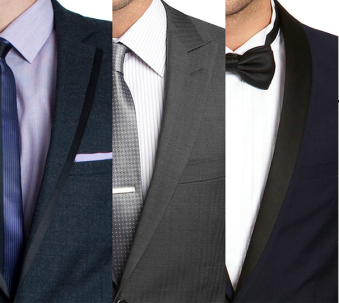
From left to right: notch lapel, peak lapel, shawl lapel.
Notch lapels look like someone just cut a triangle on the top part of your lapel. They are the most common type of lapel, and the most versatile in that they can be used in casual and formal jackets.
Peak lapels have the bottom point peak past the top part, hence the name. They’re a more dressy and old-school option,most commonly found in DB jackets. Peak lapels are best reserved for business.
Shawl lapels are shaped like a smooth band. Shawls are as dressy as jacket lapels come, they’re predominant in tuxedos and dinner jackets, suited (again, with the puns) to black-tie and white-tie events. Although, some fashion-forward individuals can pull them off in a more casual setting.
Lapel Widths
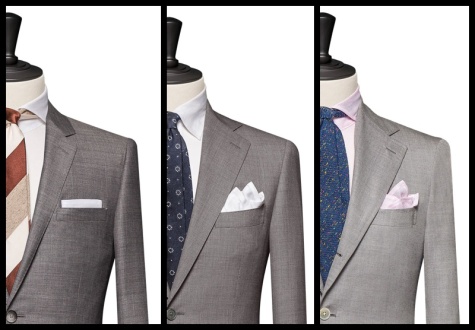
Left to right: narrow, medium, wide
The width of your lapel should compliment your build, and the width of your ties. For example, those of slight build would do well to don a narrow lapelled jacket with a skinny tie; conversely, wide lapels with wide ties work for those of a more full body.
The Lapel Button Hole
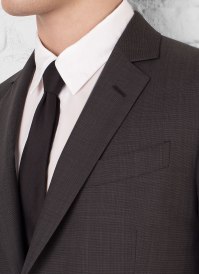 Notice that near the lower tip of the left lapel, there is a small slit. It’s there so jackets can button all the way up; high-end models generally have this feature. It’s also where flowers go. As is often worn in Western-style weddings.
Notice that near the lower tip of the left lapel, there is a small slit. It’s there so jackets can button all the way up; high-end models generally have this feature. It’s also where flowers go. As is often worn in Western-style weddings.
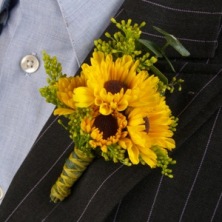 Don’t go sticking sunflowers in it.
Don’t go sticking sunflowers in it.
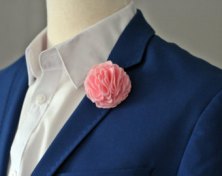 Smaller flowers like carnations work better.
Smaller flowers like carnations work better.
The Pockets
The Chest Pocket
Now, notice the much bigger slit south of the boutonniere, that is the welt, also known as the breast pocket.
 That’s where ballers put their money.
That’s where ballers put their money.
But for us regular folk, a textile pocket square works fine.
 Don’t leave the chest pocket empty.
Don’t leave the chest pocket empty.
Waist Pocket Types
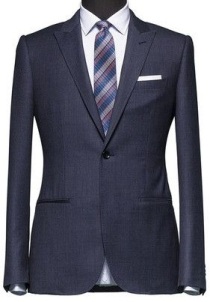 Jetted pockets are simply slitted pockets, which enter between the jacket and the lining. They are the most formal option.
Jetted pockets are simply slitted pockets, which enter between the jacket and the lining. They are the most formal option.
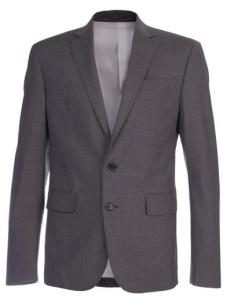 Flap pockets are literally jetted pockets with flaps, they can be worn out or tucked in to look like a regular jetted pocket. They are in the middle of the formality spectrum.
Flap pockets are literally jetted pockets with flaps, they can be worn out or tucked in to look like a regular jetted pocket. They are in the middle of the formality spectrum.
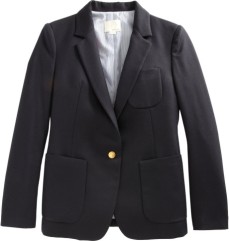 Patch pockets are actually sewn onto the outside of the garment. They’re the least dressy of the bunch. History has it, that these were useful way back when people hunted with sport coats, for quick access to bullets and other gear.
Patch pockets are actually sewn onto the outside of the garment. They’re the least dressy of the bunch. History has it, that these were useful way back when people hunted with sport coats, for quick access to bullets and other gear.
Extra Pockets
Some jackets will even have extra pockets, usually above the right waist pockets.
The ticket pocket (left) and the hacking pocket (right), were designed for easy access. As the times changed, the former became mostly irrelevant, especially now that we can keep digital tickets in our smartphones. The latter suffered the same fate, it was useful back when people rode horses, and had to fish something out of their pocket mid-gallop. A nice decorative touch, nonetheless.
The Lining
The lining is the inside layer that sits between the jacket’s fabric and you. Its purpose is to provide structure within the jacket, and it serves as an insulating layer.
There are three levels of lining, as displayed in the picture below:

Fully-lined jackets have a high capacity to keep their shape and are more durable than the other styles; also, the lining makes donning and doffing the jacket easier, since it fully covers the jacket’s inside. It is the least breathable, however.
Half-lining, is a happy medium between fully-lined and unlined. The location and amount of the lining varies, it can cover just the inside of the arms and shoulders, or everything but the lower back portion.
Unlined (a.k.a. skeleton-lined; a.k.a. minimal lined; a.k.a. unlined) jackets offer the best in terms of breathability, and they’re a great option for warmer climates. The trade-off is less durability and structure, since there’s no internal support.
Extra, Extra Pockets
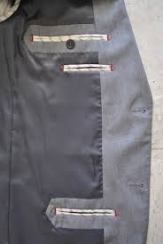
If there’s one thing that’s great about blazers and other jackets, it’s that they have lots of pockets. In the lining, you’ll find even more of them, which is great because you won’t have to stretch out your slim-fit pants with a bulky phone and other daily carry essentials.
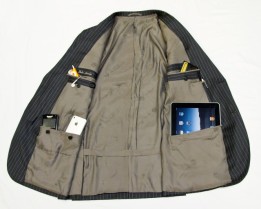
Only the bare necessities, right Baloo?
Moving on to the sides of the jacket…
The Shoulders
Jacket shoulders are classified as either structured (left) or unstructured (right). “Structure” refers to the degree of padding, and its stiffness, on the shoulders.
A structured shoulder is more padded, giving it a sharp-looking edge where the sleeve connects to the rest of the garment. It’s the more formal option.
An unstructured (a.k.a. natural) shoulder is minimaly padded and it follows the contour of the wearer’s shoulders. This style is most at home in smart-casual or business-casual environments.
The Cuffs
Cuff Types
There are two types of cuffs, functional and non-functional.Functional cuffs are usually a sign of quality in a jacket’s construction.
Functional cuffs can be unbuttoned. Non-functional cuffs, cannot.
The Cuffs’ Buttons
Now we’re really getting surgical. Notice the way the buttons are spaced out.
From left to right: Non-kissing; kissing; stacked.
The arrangement of the cuffs’ buttons is a minor detail; it’s a matter of personal style, really. Either type is adequate.
Lastly, the back of the jacket…
The Vents
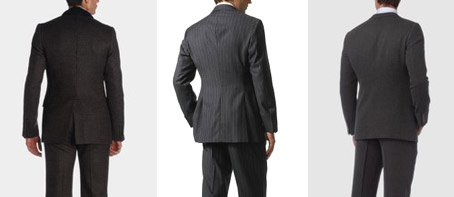
From left to right: single-vented, double-vented, non-vented.
Single-vented types have the one slit down the middle. It is the most widely available style.
Double-vented styles have two openings on the back closer to the side, which allow a more natural fit. Double vents are another sign of quality construction. They feel the most comfortable when closed,and when sitting down or moving around.
Non-vented jackets… are non-vented. They will have a tighter feel. Politicians are rumored to use them as they are often standing; take from that what you will.
One More Teeny Tiny Little Detail
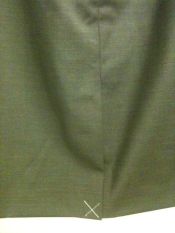 That X-string on your new blazer… Cut it.
That X-string on your new blazer… Cut it.
Let’s try to consolidate all this information.
Suggestions for a suit jacket, to be used in formal situations are: two buttons, in a single breast; medium button-stance; medium width and notched lapel; structured shoulders; jetted pockets; horn buttons, a full lining; functional cuffs ;double-vented.
For a smart-casual scenario, a sport jacket could be pretty much the same as the suit jacket, but with some other details. Soft unstructured shoulders, mother-of-pearl buttons, a half-lining, and patch pockets.
I hope it all makes a bit more sense, now.
Congrats on finishing the article. It was a lengthier read than usual, but you just cracked the code. You are almost ready to buy your perfect jacket. Stay tuned for the fit guide, in which I’ll explain the details of a proper fitting jacket.
Thank you for reading Principles of Style. I hope you enjoy this post and found the blog useful. If you have any questions, feedback, or want to share some of your style and scent tips, tricks, and insights, please leave your input in the comments section below, or send me a PM.
Did I miss anything? Do you disagree? Do you love it? Have I changed your life? Let me know.
To receive more content sooner, automatically delivered directly to you, please subscribe by clicking the “follow” icon on the bottom right, and entering your email for updates.
Follow me on Twitter at https://twitter.com/PrincipleoStyle
Follow me on Instagram at: https://www.instagram.com/principlesofstyle/?hl=en
If you are reading from the home page, the comments button will be above, under the title picture.
Please comment, like, subscribe, and follow.
Stay dashing, my friends.



















One thought on “Suits: The Anatomy of a Suit Jacket”